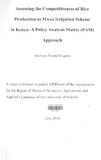| dc.description.abstract | This study aimed at comparing the costs of inputs and value of outputs in rice production
systems at both local and world markets. This facilitated to assess the profitability of
producing rice in Mwea Irrigation Scheme and determine its competitiveness vis-a-vis rice
imports. The inputs included hired and family labour; chemical fertilizer, machinery and
water; petrol, diesel and electricity in production, transportation, processing and marketing
phases.
The input costs and value of output on production, transportation, processing and marketing
were collected through comprehensive structured Policy Analysis Matrix (PAM)
questionnaires. They were administered to 93 farmers, 68 paddy transporters, 37 rice
processors and 32 white rice wholesalers. Analysis was done in Census and Survey
Processing System (CSpro) and imported to Excel spreadsheet.
The results of the study showed that rice production in Mwea Irrigation Scheme (MIS) was
profitable. The financial and social profits were estimated at Kshs 36,728 and Kshs 25,515
per acre, respectively. The private cost ratio (PCR) was OA showing that the system could
afford to pay domestic factors and still remain competitive earning normal profits. The net
transfer was Kshs 10.10 per kg showing a high absolute figure. Domestic Resource Cost
(DRC) was OA1. This meant that the system in MIS was costing less than a dollar of
domestic resources to earn a dollar of foreign exchange. Nominal Protection Coefficient on
Output (NPCO) and input (NPCI) equals lAO and 1.23, respectively. The Profitability
Coefficient (PC) was equal to lA3, while the Subsidy Ratio to Producers (SRP) was
computed to be 0.23. This indicator showed that the output tariff equivalent required to
maintain the existing private profits if all other policy distortions and market failures were
eliminated was 23 per cent.
The recommendations from the findings of the study and preferred for the sub-sector were
four. One, development of a water reservoir upstream to improve supply of water flooding in
increased number of paddy fields (in Ngothi, Kiarukung'u and Kiamanyeki out-growers),
consequently operationalizing rice production system competitively. Two, relax the current
restrictive policy on imported broken rice and Pishori grain to enable price stability in the
market. Three, a policy in favour of investors must be instituted so that investments make a
minimum excess economic profit of 10% for sustainability. In addition, an introduction of 13
per cent subsidy on tradable inputs (chemical fertilizers and herbicides) be implemented to
cushion farmers on observed high input transfers to importers and fourth, promotion of
agricultural based financial institution with incentives for farmers is critical to competitively
stabilize the price of credit. | en |

